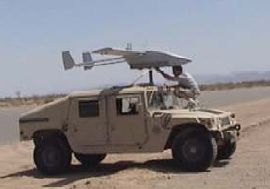Navmar XPV-2 Mako
The XPV-2 Mako UAV was developed by Navmar Applied Sciences Corp. as a low-cost long-endurance tactical mini-UAV. 30 UAVs were procured by the U.S. Special Operations Command, and were successfully used during Operation Iraqi Freedom. The Mako is cheap enough to be expendable, if the tactical or logistical situation favours discarding the air vehicle.
 |
| Photo: Navmar Applied Sciences |
| Mako |
The Mako is of conventional UAV layout, featuring a tricycle undercarriage (wheels or skids), a twin-boom tail, and a piston engine driving a pusher propeller. It can be launched from atop a vehicle driving down a short stretch of runway, and is retrieved by a conventional horizontal landing. The Mako can loiter for more than 7 hours, and has a maximum payload capacity of 13.6 kg (30 lb). It is equipped with a GPS navigation system, a two-way datalink, and an L-band video downlink. Features added during evaluation by the U.S. military include navigation and strobe lights, a new high-resolution digital camera, and the option to control the aircraft from two GCSs (Ground Control Stations). Standard payloads are daylight or infrared reconnaissance cameras.
Specifications
Note: Data given by several sources show slight variations. Figures given below may therefore be inaccurate!
Data for XPV-2 Mako:
| Length | 3.02 m (9 ft 11 in) |
| Wingspan | 3.86 m (12 ft 8 in) |
| Weight | 64 kg (140 lb) |
| Speed | max: 130 km/h (70 knots); cruise: 83 km/h (45 knots) |
| Ceiling | 3000 m (10000 ft) |
| Range | 75 km (40 nm) |
| Endurance | > 7 h |
| Propulsion | 3W piston engine; 7.8 kW (10.5 hp) |
Main Sources
[1] "Unmanned Aircraft Systems Roadmap, 2005-2030", Office of the Secretary of Defense, August 2005
[2] Navmar Applied Sciences Website
Back to Directory of U.S. Military Rockets and Missiles, Appendix 4
Last Updated: 1 September 2005